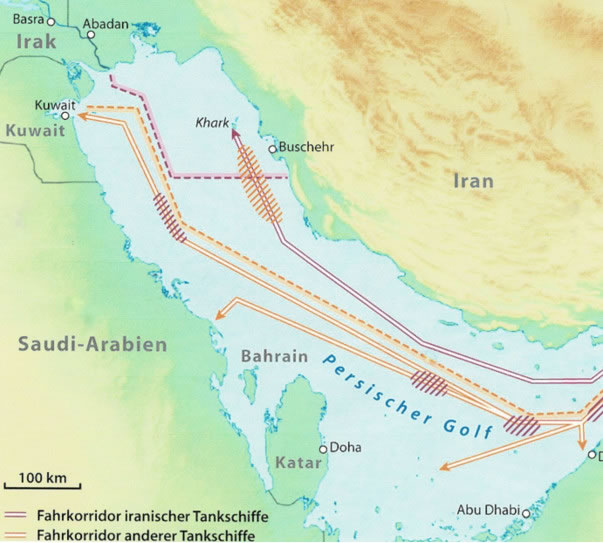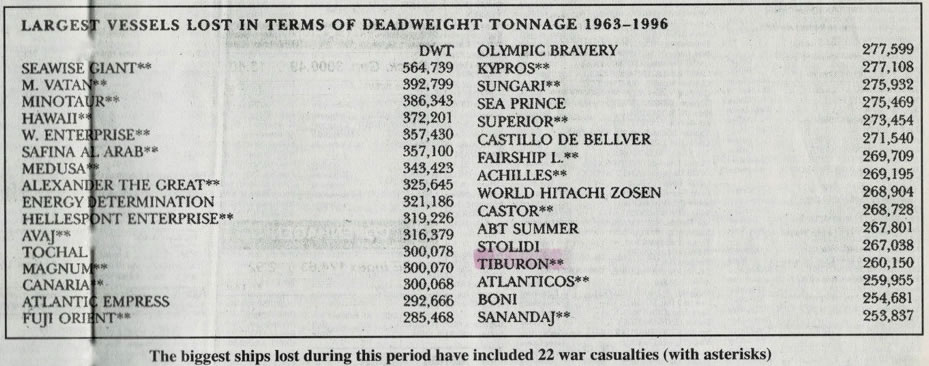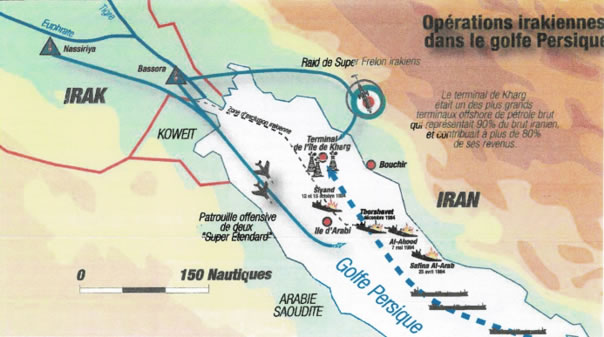
This steam turbine-powered tanker was built in Sweden and first sailed under the Swedish flag. Launched on 18.08.1973 as SEA SCOUT. Commissioned in October 1973 by Salénrederierna A/B Stockholm (management: Salénrederierna, Stockholm) and registered under Swedish flag, home port Stockholm (call sign SMUT). Sold in 1981 to Partrederiet för t/t "Sea Scout" Stockholm (Management: Salén Tanker A/B, Stockholm) and resold in 1982 to Jenit Tank A/B, Gothenburg (Management: Zenit Shipping A/B, Gothenburg).
One Friday afternoon in June 1984, a German-speaking stranger called Suisse-Outremer and asked if they were interested in managing a supertanker. The man said he was on his way to Zurich in his private plane. So three of Suisse-Outremer's top people drove to the airport to meet the man. He turned out to be a so-called trader, an international commodities trader who worked for an Austrian state trading company.
The trader let it slip that he was also in contact with a shipping company in Geneva and that a decision would have to be made quickly. The director, Rolf Greter, was excited and did not want to miss this rare opportunity, he probably only heard "supertanker". The tanker was anchored outside the Persian Gulf, off Khor Fakkan, an exclave of the Emirate of Sharjah, and a was also available, either in Dubai or on the island of Kharg, off the Iranian coast.
An agreement was quickly reached and on 21.06.1984 the new owner took over the tanker for a price of 8 million USD. The new owner company was called Seavision Investment SA and the management was now with Suisse-Outremer Reederei AG, Zurich. The tanker was renamed TIBURON (Spanish for shark) and registered in Monrovia under the Liberian flag (call sign ELDU8). Note: The Liberian fleet is managed from New York. Now things had to move quickly, many things had to be organised, especially a crew. Engineers with a steam certificate and experience on turbine ships were also needed; these people were difficult to find even then. In the end, they had a crew of 31 men, 24 Spaniards and 7 Germans. The captain, chief officer, chief engineer, 1st. Assistant Engineer, 3rd. Assistant Engineer, as well as the electrician and the cook were from Germany.
Insurance policies also had to be taken out for "Hull & Machinery" (hull insurance), "P&I, Protection & Indemnity" (liability insurance), as well as war risk insurance. The seafarers all had a Swiss union employment contract (VHTL) and were thus subject to the Swiss Health and Accident Insurance Act.
On 21.06.1984, the SEA SCOUT was taken over at anchor in Khor Fakkan by the new crew and renamed TIBURON. All the necessary surveys for the change of name, owner and flag were carried out here. After the takeover, the TIBURON moved to a waiting position behind an Iranian island in the Strait of Hormuz, thereafter absolute radio silence had to be maintained. Then she sailed to the island of Kharg to load two lots, one heavy and one light crude oil. The shipping company only knew from the agency that the tanker was due to leave in the morning of Wednesday 27.06.1984, so it would be out of the danger zone by the evening.
However, things turned out differently, the shark suddenly became the hunted, at noon a Dutch salvage company called the office in Zurich to ask if the TIBURON was their ship, their salvage tug in Dubai had picked up an SOS call, ten minutes later the representative of a Singapore salvage company called from London. After this accident report had leaked out to the public, the telephone and the shipping company's office were assailed by all kinds of people, journalists, local radio stations, advocates, trade unionists, the Spanish consul, etc. Even the Baron (Hans Heinrich von Thyssen-Bornemisza, the real owner of Suisse-Outremer) called personally and wanted to know how the support of the bereaved families stood.
The TIBURON had departed Kharg Island on schedule on the morning of 27.06.1984 with a cargo of 250,000 tons of crude oil *) and was at sea heading for the Strait of Hormuz when an Exocet missile struck at 13:40 local time, causing the immediate failure of all engines and systems, darkness prevailed on board. The steamer was at position 28° 27' N / 050° 45' E, north of Bahrain. As the superintendent who was travelling with the ship told us later, he was standing on the bridge with the captain and the chief engineer when, as if out of the blue, the missile penetrated the starboard side about 1.5 m above the waterline through the diesel oil daily tank into the tween deck in the engine room and exploded there. Apparently the Iraqi aircraft were not noticed, the Exocet missile was fired from a safe distance. The two steam boilers also exploded, anyone who had not already died from the exploding missile was now instantly scalded by the hot steam, no one can survive such an accident **). Seven men died instantly in the engine room, an eighth man dragged himself out of the steering gear room via the emergency exit. An Iranian helicopter flew the seriously injured man to Bushehr hospital, where he unfortunately died. Three other seamen lay on the deck seriously injured. One can of course ask why these people were sent to the engine room while the tanker was moving in the danger zone. The ship was well maintained and could run on automatic. Was there urgent work to be done, or did people just go into the engine as a matter of habit, it being Wednesday, a normal working day? We do not know.

Seamen also called the route in the Persian Gulf "Exocet Alley"- Source: Wikipedia
The TIBURON was now ablaze aft, fortunately the crude oil cargo remained unharmed. The Spanish radio operator sent his SOS message until the superintendent got him out of the radio cabin which had become filled with dense smoke. The rest of the crew rescued themselves onto the forecastle. Three Iranian tugboats reached the accident site first, but it was possible to prevent the Iranians from bringing the wreck to their coast, which would not have been in the interest of the shipping company and the insurers. In the meantime, Iranian helicopters took the crew and the three wounded men to Bushehr hospital. The seafarers were treated correctly by the Iranians and flown directly home afterwards.
In the meantime, the shipping company organised the Dutch salvage company Smit-Tak and a salvage contract was concluded on a "no cure, no pay" basis. Their salvage tug, together with a tug from Singapore, reached the TIBURON around midnight and towed the burning tanker to an anchorage about 70 nautical miles east of Bahrain. Only the ship's master and chief engineer and the superintendent remained on board. They were then given the opportunity to eat and sleep on board the salvage tug. In the afternoon of 30.06.1984, the fire was finally extinguished. After cooling down, they began to salvage the cargo on 15.07.1984. The crude oil cargoes were salvaged by being pumped into the BP tanker BRITISH RENOWN ***) and into another tanker and could be salvaged.
The recovery and repatriation of the dead posed a particularly delicate problem. The bodies lay scattered in the engine room, which was completely filled with extinguishing water. The salvage company insisted that for technical reasons the engine room should not be pumped empty until the crude oil had been recovered. The reason was probably that the tanker maintained a good trim by the stern, or else that the salvors simply cared more about the cargo. It must be remembered that the cargo pumps and the ship's stripping system could not be used (no steam, no electricity on board), so the tanks had to be discharged with portable pumps from the salvage vessels.
Finally, after more than four weeks, the time had come, on 01.08.1984, the engine room was pumped dry. The insurance company's adjuster organised a funeral home that was supposedly specialised in such cases. The boss himself, with two assistants and seven coffins, flew to Bahrain and took a boat to the TIBURON. Arriving alongside, the three refused to climb the high gangway, they wanted to wait until the bodies were brought down to them. An Anglican priest in Bahrain sent some Pakistani gravediggers on board. These people came on deck, but when they saw the inferno in the engine room, their courage left them, they did not want to go down into that hell. Next, a call to the US Navy in Bahrain, the right man answered but said "yes if they are Americans, right away, but foreigners? No thanks, unfortunately we can't help". The crew of the Dutch salvage tug also refused, not even for a premium would they do the work. Finally, the captain had the redeeming idea, the Dutch had chartered another tug with a Filipino crew from Singapore. For a premium of 2000 USD, they had recovered the corpses and brought them down to the boat. The captain arranged the repatriation of the corpses with the undertaker, after which the said undertaker and his assistants, the Pakistani gravediggers and the seven coffins left with the boat back to Bahrain.
The TIBURON was insured for 9 million USD and the salvage experts declared her a total loss. The wreck was then sold for demolition to Tien Cheng Steel Manufacturing Co. Ltd. Kaohsiung, Taiwan (published scrap price: 90.- USD per light weight ton, total 2,947,320 USD). Departed from the Arabian Gulf on 19.08.1984 under the name STIB in tow and arrived in Kaohsiung, Taiwan on 12.11.1984. Demolition began on 28.11.1984.
Even though the ship had long since been scrapped, the battle continued for years with lawyers and courts over who had to pay what and how much. Lloyds in London paid one of the highest salvage awards, a total of 15.8 million USD.
*) The value of this cargo of 250'000 metric tons was about 49 million USD. Taking 250,000 tonnes with a S.G. of 0.9 gives 277,770 m³, divided by 0.159 (1 barrel = 159 ltr.) gives 1,750,000 barrels. At a price of about 28 USD per barrel at the time, this gives about 49 million USD.
**) According from Lloyd’s information the boiler of the TIBURON had a steam pressure of 72,0 bars and the pressure at the turbine inlet was 64,7 bars. The steam was superheated and had a temperature of 510°C. For comparison, the exhaust and donkey boilers on the freighters 40/60 years ago produced saturated steam and had a steam pressure of about 7 - 10 bar, corresponding to a temperature of 165 - 180°C., so the steam pressure on the TIBURON was about 7 to 10 times higher and the temperature 3 times higher.
***) BRITISH RENOWN, this tanker in turn was attacked by Irani fighter planes and shot at. Nobody was hurt and the ship suffered only minor damages, which were repaired in Dubai.
Additional Information and Stories
First Gulf War (Iraq/Iran War), also called Tanker War
This war arose out of centuries-old border disputes, still unresolved today, and lasted from 22.09.1980 to 20.08.1988. The immediate cause that led to the Gulf War, also called the Tanker War, was navigation rights on the Shatt al-Arab (Arvand Rud) and the "liberation" of the oil and gas-rich Iranian province of Khuzestan (called Arabistan in Iraq).
Iraq under Saddam Hussein enjoyed considerable support from the Soviet Union, France and the United States, while revolutionary Iran received little international support. After the French supplied the Iraqis with "Super Étendard" fighter planes and Exocet missiles and Iraq thus gained air supremacy, this led to the so-called "tanker war". They tried to make each other's oil exports more difficult or even prevent them.
Tanker total losses from 1963 to 1996, most sunk by war action (with asterisk), but list not complete. Source: Lloyd’s List, 2. July 1997
According to various media, a total of about 250 tankers were damaged or sunk, but it seems that this number is much too high. In Iran, the oil loading terminal is located on the Kharg Island and the tankers leaving there were a target of the Iraqis. For their part, the Iranians attacked the tankers departing from Iraq and Kuwait with naval mines, guided missiles and shelling by warships. The seafarers therefore also called the dangerous stretch between the Shatt al-Arab and the island of Larak in the Strait of Hormuz "Exocet Alley".

Source: Le Fana de l'aviation, April 2016 from Hugues de Guillebon
Sources:
- Lloyds Register Publications
- Marine News World Ship Society
- Capt. Jörg Johannsen
- Wikipedia
- Hugues de Guillebon, Aviation Journalist
SwissShips July 2023